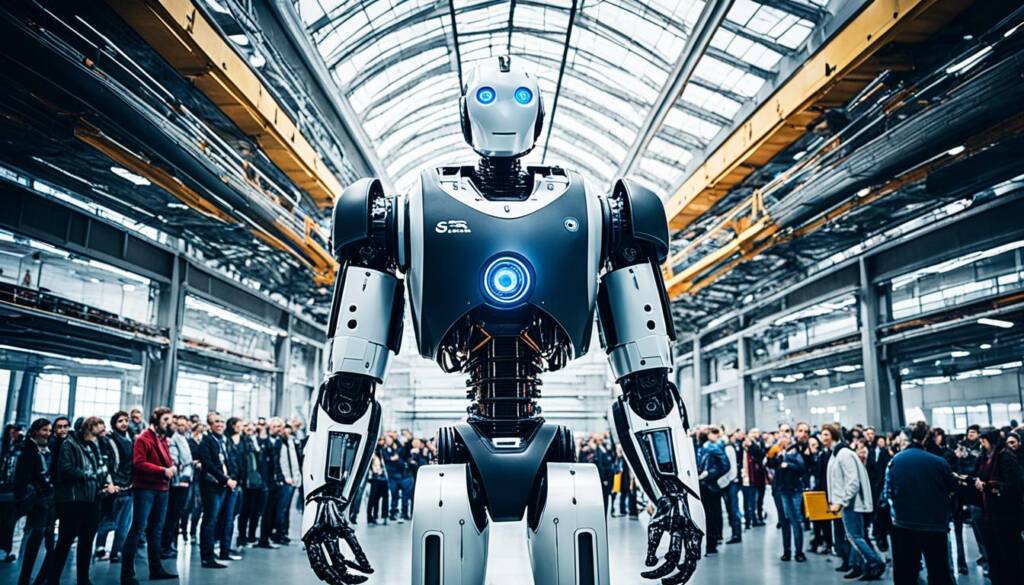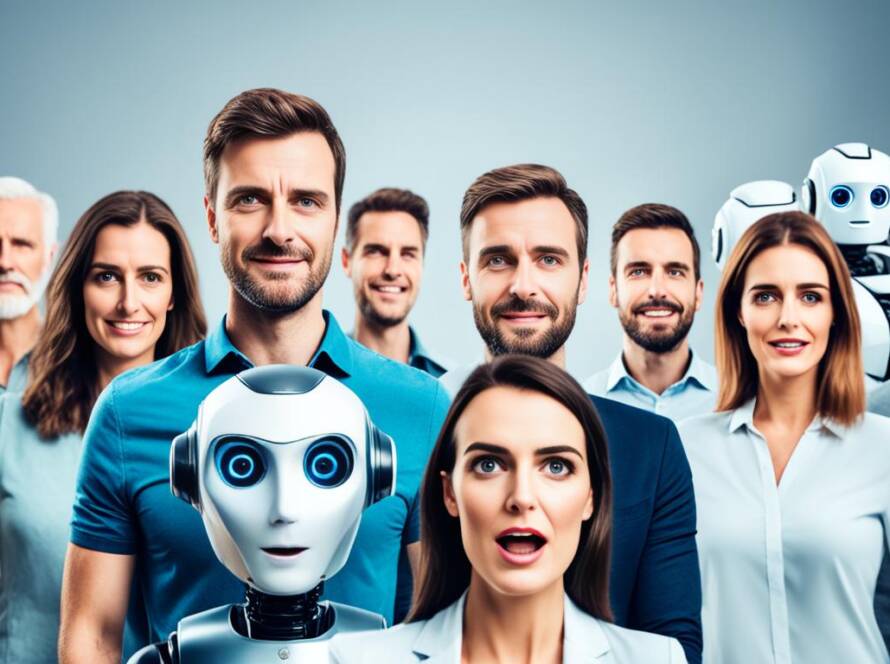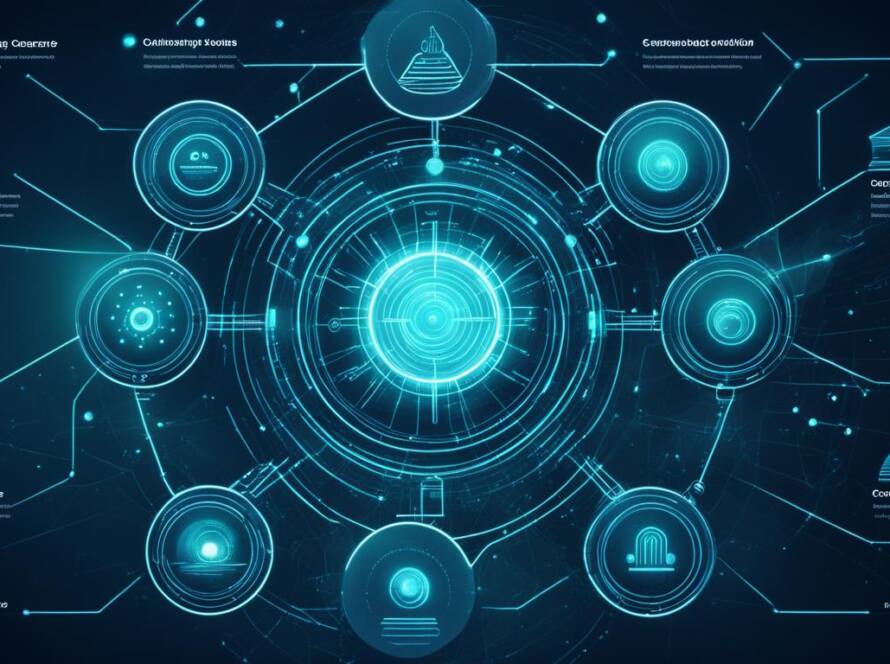Acceptance and opposition to AI vary widely among people, with opinions ranging from full support to strong resistance. Recent studies show growing interest in AI, but opinions remain divided. A survey by Jonathan Dupont, Seb Wride, and Vinous Ali found that most people in the UK are aware of AI, yet 5% were still unfamiliar with it in 2023. Additionally, only 55% of respondents felt confident in explaining what AI is, highlighting the ongoing debate and mixed reactions surrounding its adoption and impact1.
Younger people, under 35, are more likely to use AI tools like ChatGPT, with 46% of adults in this group using it1. This shows how different people see AI in different ways.
There’s a big debate on how to accept AI. People see both the good and the bad sides. Many worry about losing jobs and how AI will change society. That’s why 57% think the government should act to stop AI from replacing human jobs1. Trust in AI varies around the world, showing we need better info and education on it.

Key Takeaways
- A vast majority of the UK population is familiar with AI, yet only 55% can confidently explain it1.
- Younger generations show higher usage rates of AI tools like ChatGPT, with 46% usage among adults under 35 years old1.
- AI acceptance is mixed with 57% supporting government interventions to prevent job displacement1.
- Trust in AI varies globally, indicating the need for better communication and education on AI1.
- Public opinion is divided between excitement for AI’s potential benefits and concerns over its societal impacts1.
Public Perception of Artificial Intelligence
The way people see artificial intelligence (AI) has changed a lot, making more people interested. This change shows how AI affects different people in different ways. It’s clear that what people think and feel about AI comes from their age and personal stories.
Rising Awareness of AI
More people are learning about AI, especially in the past year. This is shown by Google Trends. Even though more people know about AI, not everyone uses tools like ChatGPT. For example, 85% of Americans use some kind of AI tool, but not everyone knows how they work2.
Generational Differences in Familiarity
People of different ages have different levels of AI knowledge. Young people under 35 are more likely to use AI than older people. This shows we need to teach everyone about AI to make sure everyone can use it well. Everyone, no matter their age, thinks AI will develop fast, showing we all share similar hopes for its future.
Emotional Responses to AI
People have many feelings about AI, from being curious to worried. Some people are excited about what AI can do, but others worry about its risks. Young people often think companies should be in charge of making AI safe, while older people want clear rules for AI decisions3. But most people are not too scared of AI and see both good and bad sides to it.
| Generational Group | AI Engagement | Expectation of Rapid AI Development |
|---|---|---|
| Under 35 | High | High |
| 35-50 | Moderate | Moderate |
| Over 50 | Low | Moderate |
Impact of AI on Work and Society
AI’s effect on society is complex, especially in the labour market and job sectors. It’s becoming more part of our daily lives, bringing both good and bad changes.
Automation and Job Displacement
Many worry about job loss due to automation, mainly in jobs that need repetitive tasks. Studies say 14% of jobs in OECD countries could be fully automated, and another 32% will change a lot4. Automation hasn’t led to fewer jobs overall, but low-skilled workers in manufacturing have seen income drops5. AI could boost productivity by 11-37% by 20354. Yet, people are worried about job quality and security, with 64% expecting more unemployment from AI6.
Experts like Acemoglu and Johnson (2023) believe AI can work with humans to reduce job loss and monitor workplaces6. But, there are concerns that we’re not seeing big productivity gains, which could widen economic gaps6. Still, history shows that AI could improve our lives, just like the first industrial revolution did5.
AI in Day-to-Day Life
Not everyone uses AI every day, but it’s used in many ways, like spam filters and chatbots. It makes our daily tasks easier and helps with things like reducing greenhouse gases by 1.5-4% by 20304.
AI can also cut costs and open new possibilities in areas like transport, education, energy, and waste management4. Yet, Acemoglu and Johnson point out AI’s biases and focus on automation could harm workers6. We need to be careful with AI, using it in ways that protect our privacy and data4.
Acceptance and Opposition to AI
Artificial intelligence has many benefits, like making things more efficient and helping in medical diagnostics. It’s changing how we work and improving health care. For example, AI helps find diseases early and accurately.
Positive Impacts of AI
AI is changing many areas for the better. It’s making medical diagnostics better by finding diseases early and accurately. People are more open to AI when they see how it helps solve problems and make things more efficient.
Younger people and those who are more agreeable tend to accept AI more easily7. This shows how attitudes towards AI can vary.
Concerns and Ethical Considerations
However, there are big worries about AI too. Some fear it could take jobs and reduce human decision-making. People who believe in conspiracy theories might be more doubtful about AI7.
There are also worries about AI’s biases and lack of common sense8. These concerns are more common among certain groups like women, the elderly, and minorities7. Privacy issues, like surveillance and deepfakes, are also big concerns8.
Control and Regulation
As AI grows, we need to think about how to control it. Many people think the government should lead in making sure AI is used right. There’s a push for special groups to watch over AI to balance innovation with safety.
Being open about AI’s workings and how well it performs is key to getting people on board9. By being fair and open, we can make sure AI is accepted and used wisely in our lives.
Everyone agrees AI could change a lot for the better. But, there’s a strong call for responsible, ethical, and fair AI development. This shows we understand AI’s power and want to use it for good, not harm.
Conclusion
We stand at a key moment as we blend artificial intelligence (AI) into our world. The future of AI is full of possibilities, touching everything from healthcare to education. Yet, it comes with big challenges and tough choices. For instance, AI could lead to workers being exploited10. There are also worries about our privacy and human rights when using AI10.
Finding the right balance between controlling AI and letting it grow freely is vital. AI could help our economy grow and make us more productive. But, it might also take jobs and exploit workers10. In healthcare, AI is changing fast, with most recent articles talking about its role11. But, we must think about ethics, like who is accountable and how it affects our feelings10.
To use AI wisely, we need trust and understanding. Laws and ethics must keep up with AI’s complex nature. This means dealing with issues like who is responsible and how AI affects our relationships10. By finding the right balance, we can reduce risks and make sure AI helps everyone fairly. Our goal is to use AI in a way that protects our values and improves our lives.
Source Links
- https://publicfirst.co.uk/ai/
- https://www.mdpi.com/2076-0760/12/9/502
- https://www.adalovelaceinstitute.org/report/public-attitudes-ai/
- https://www.europarl.europa.eu/topics/en/article/20200918STO87404/artificial-intelligence-threats-and-opportunities
- https://www.thebritishacademy.ac.uk/documents/279/AI-and-work-evidence-review.pdf
- https://link.springer.com/article/10.1007/s00146-024-01959-3
- https://www.nature.com/articles/s41598-024-53335-2
- https://www.linkedin.com/pulse/arguments-against-ai-adam-edgell-bush
- https://link.springer.com/article/10.1007/s00146-023-01649-6
- https://www.europarl.europa.eu/RegData/etudes/STUD/2020/634452/EPRS_STU(2020)634452_EN.pdf
- https://www.ncbi.nlm.nih.gov/pmc/articles/PMC9908503/


